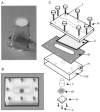A novel mechanism of neutrophil recruitment in a coculture model of the rheumatoid synovium
- PMID: 16255036
- PMCID: PMC3119436
- DOI: 10.1002/art.21394
A novel mechanism of neutrophil recruitment in a coculture model of the rheumatoid synovium
Abstract
Objective: Rheumatoid arthritis (RA) is classically thought of as a Th1, T lymphocyte-driven disease of the adaptive immune system. However, cells of the innate immune system, including neutrophils, are prevalent within the diseased joint, and accumulate in large numbers. This study was undertaken to determine whether cells of the rheumatoid stromal microenvironment could establish an inflammatory environment in which endothelial cells are conditioned in a disease-specific manner to support neutrophil recruitment.
Methods: Human umbilical vein endothelial cells (ECs) and fibroblasts isolated from the synovium or skin of RA patients were established in coculture on opposite sides of porous transwell filters. After 24 hours of EC conditioning, the membranes were incorporated into a parallel-plate, flow-based adhesion assay and levels of neutrophil adhesion to ECs were measured.
Results: ECs cocultured with synovial, but not skin, fibroblasts could recruit neutrophils in a manner that was dependent on the number of fibroblasts. Antibody blockade of P-selectin or E-selectin reduced neutrophil adhesion, and an antibody against CD18 (the beta2 integrin) abolished adhesion. Blockade of CXCR2, but not CXCR1, also greatly inhibited neutrophil recruitment. Interleukin-6 (IL-6) was detectable in coculture supernatants, and both IL-6 and neutrophil adhesion were reduced in a dose-dependent manner by hydrocortisone added to cocultures. Antibody blockade of IL-6 also effectively abolished neutrophil adhesion.
Conclusion: Synovial fibroblasts from the rheumatoid joint play an important role in regulating the recruitment of inflammatory leukocytes during active disease. This process may depend on a previously unsuspected route of IL-6-mediated crosstalk between fibroblasts and endothelial cells.
Figures






Similar articles
-
Duffy antigen receptor for chemokines and CXCL5 are essential for the recruitment of neutrophils in a multicellular model of rheumatoid arthritis synovium.Arthritis Rheum. 2008 Jul;58(7):1968-73. doi: 10.1002/art.23545. Arthritis Rheum. 2008. PMID: 18576313 Free PMC article.
-
The role of vascular cell adhesion molecule 1/ very late activation antigen 4 in endothelial progenitor cell recruitment to rheumatoid arthritis synovium.Arthritis Rheum. 2007 Jun;56(6):1817-26. doi: 10.1002/art.22706. Arthritis Rheum. 2007. PMID: 17530710
-
Activation of endothelial extracellular signal-regulated kinase is essential for neutrophil transmigration: potential involvement of a soluble neutrophil factor in endothelial activation.J Immunol. 2003 Dec 1;171(11):6097-104. doi: 10.4049/jimmunol.171.11.6097. J Immunol. 2003. PMID: 14634124
-
[Rheumatoid arthritis: new developments in the pathogenesis with special reference to synovial fibroblasts].Z Rheumatol. 2001 Oct;60(5):309-18. doi: 10.1007/s003930170030. Z Rheumatol. 2001. PMID: 11759230 Review. German.
-
Leukocyte-endothelial cell interactions.Semin Hematol. 1993 Oct;30(4 Suppl 4):45-53; discussion 54-5. Semin Hematol. 1993. PMID: 8303310 Review.
Cited by
-
Global trends in research of fibroblasts associated with rheumatoid diseases in the 21st century: A bibliometric analysis.Front Immunol. 2023 Feb 10;14:1098977. doi: 10.3389/fimmu.2023.1098977. eCollection 2023. Front Immunol. 2023. PMID: 36845163 Free PMC article.
-
Why does chronic inflammation persist: An unexpected role for fibroblasts.Immunol Lett. 2011 Jul;138(1):12-4. doi: 10.1016/j.imlet.2011.02.010. Epub 2011 Feb 17. Immunol Lett. 2011. PMID: 21333681 Free PMC article. Review.
-
Comparative Ability of Mesenchymal Stromal Cells from Different Tissues to Limit Neutrophil Recruitment to Inflamed Endothelium.PLoS One. 2016 May 12;11(5):e0155161. doi: 10.1371/journal.pone.0155161. eCollection 2016. PLoS One. 2016. PMID: 27171357 Free PMC article.
-
The role of interleukin-6 signalling and its therapeutic blockage in skewing the T cell balance in rheumatoid arthritis.Clin Exp Immunol. 2017 Jul;189(1):12-20. doi: 10.1111/cei.12966. Epub 2017 Apr 20. Clin Exp Immunol. 2017. PMID: 28369786 Free PMC article. Review.
-
Regulation of a lymphocyte-endothelial-IL-6 trans-signaling axis by fever-range thermal stress: hot spot of immune surveillance.Cytokine. 2007 Jul;39(1):84-96. doi: 10.1016/j.cyto.2007.07.184. Cytokine. 2007. PMID: 17903700 Free PMC article. Review.
References
-
- Dunon D, Piali L, Imhof BA. To stick or not to stick: the new leukocyte homing paradigm. Curr Opin Cell Biol. 1996;8:714–23. review. - PubMed
-
- Wong SH, Lord JM. Factors underlying chronic inflammation in rheumatoid arthritis. Arch Immunol Ther Exp (Warsz) 2004;52:379–88. review. - PubMed
-
- Rainger GE, Nash GB. Cellular pathology of atherosclerosis: smooth muscle cells prime cocultured endothelial cells for enhanced leukocyte adhesion. Circ Res. 2001;88:615–22. - PubMed
-
- Rainger GE, Stone P, Morland CM, Nash GB. A novel system for investigating the ability of smooth muscle cells and fibroblasts to regulate adhesion of flowing leukocytes to endothelial cells. J Immunol Methods. 2001;255:73–82. - PubMed
Publication types
MeSH terms
Substances
Grants and funding
LinkOut - more resources
Full Text Sources
Other Literature Sources
Medical

